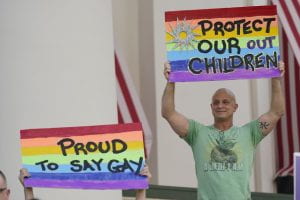Understanding Gender Diversity
As they have been for decades, students in the United States of all different sorts of identities are vulnerable to encountering inappropriate remarks or acts at some point in their lives. Bigotry, which includes many of the offensive remarks that come under the subcategories of racism, homophobia, or transphobia, includes these types of remarks. Why should we care? If it doesn’t affect us then why should we get involved? Well, it is so very important for everyone to be educated on the topic of Gender Diversity because even though it might not effect you, but it might effect the kid that sits behind you in class who always gives you a pencil when you forget one. It’s important to know how racism, homophobia and transphobia all connect to each other and that’s what I’m going to get into later in this post.
INCORPORATING LGBTQIA+ CONTENT IN HISTORY LESSONS
An exciting transition in our profession is signaled by new state history–social science frameworks that incorporate the experiences, viewpoints, and contributions of LGBTQIA+ individuals. According to the Committee on LGBT History’s report on California’s FAIR Education Act, students can “appreciate the complexity of the past, think critically and expansively about possibilities for change in the future, and discover the roles that they can play in achieving an inclusive and respectful society.”
Instructors can discover meaningful methods to include LGBTQIA+ information into the history curriculum by depoliticizing the discussion, improving the material, and making the connection between the integration and student well-being even though they may not have access to content-specific training on these subjects.
- DEPOLITICIZE THE CONVERSATION
Reiterating that curriculum representation does not include a comprehensive analysis of sexuality or the promotion of a social-political agenda is crucial. Giving students the chance to analyze the contributions and experiences of various groups is not the same as going into depth about a single person’s personal life.
- INTEGRATE INTO CONTENT
Seek for practical approaches to include LGBTQIA+ subjects in the curriculum. Creating inclusive classes is an excellent way to apply the Four-Tiered Approach. Level 1 Contributions: Students explore LGBTQIA+ historical figures and significant occasions. An method of this kind would involve researching significant occasions such as the Stonewall Riots. Level 2 Additive: LGBTQIA+ information is offered alongside a particular historical period that students are studying. For example, a study of Langston Hughes, the emergence of the homosexual rights movement, or bohemian gathering places in New York City could all be added features to a unit on the 1920s. Level 3 Transformation: Students take a variety of viewpoints when thinking about history. They might examine the industrial revolution from the perspectives of shifting social mores and gender diversity. They may look at the ways that urbanization was influenced by friendships between people of the same sex, shifting perceptions of gender roles, and the distinct domains of society that men and women occupied. Level 4 Social Action: Students have the chance to participate in important historical education about LGBTQIA+ people and apply it to issues facing their communities. Students can take part in civic action by forming a club at school or working with local organizations that help LGBTQIA+ individuals as they study the history of the fight for equality.
-
CONNECT TO WELL-BEING
There is a link between the wellbeing of students and the representation in curricula. A 2017 survey found that just “1 in 5 LGBTQ students were ever taught positive representations of LGBTQ people, history, or events in their classes.” Studies show that removing LGBTQIA+ individuals and events from history curricula contributes to the perpetuation of negative stereotypes and increased bullying of LGBTQIA+ youth. Positive curriculum, on the other hand, enhances kids’ overall school experience and fosters respect for LGBTQIA+ pupils. Students who see themselves or their identified group reflected in curriculum materials report higher levels of engagement with their school communities, improved attendance records, and a sense of safety at school, according to one poll.

Lee, W. (2022). Education Week. Stephen Sawchuk. Retrieved February 4, 2024, from https://www.edweek.org/leadership/whats-driving-the-push-to-restrict-schools-on-lgbtq-issues/2022/04.
ADDRESSING RACE IN A CLASSROOM
Taking on the difficult conversations around racism and race is not solely the responsibility of history professors. Emily Boudreau writes for Usable Knowledge, a Harvard Graduate School of Education magazine, “It is the job of every teacher, not just those in the history department, to include curriculum and sources that deal with both hard histories and narratives of resilience and agency.” I feel as though it is very important for all students to be knowledgeable to where classrooms don’t need to have an “awkward discussion” about anyone’s race or ethnicity. Journalist Holly Korbey reports that an increasing number of educators are attempting to broaden K–12 curricula “to include the narratives of people from a wider range of racial, ethnic, religious, and cultural backgrounds” as the nation’s schools become more diverse. Young people may “see themselves in the story of our shared past, they not only develop a deeper appreciation of the subject, but become more civically active,” the author claims, when history is taught with greater inclusivity. In order for appropriate action to be taken, everyone must join this campaign. In the interest of equality and freedom of speech, let’s unite and put an end to bigotry.
REFERENCES
Gonser, S. (2021, March 19). Addressing race and racism head-on in the classroom. Edutopia. https://www.edutopia.org/article/addressing-race-and-racism-head-classroom
Honey, M. (2019, June 14). Incorporating LGBTQIA+ content in history lessons. Edutopia. https://www.edutopia.org/article/incorporating-lgbtqia-content-history-lessons
Lee, W. (2022). Education Week. Stephen Sawchuk. Retrieved February 4, 2024, from https://www.edweek.org/leadership/whats-driving-the-push-to-restrict-schools-on-lgbtq-issues/2022/04.
Washington Free Beacon. (2022, June 20). PRIDE MONTH: Here’s How the Navy Is Training Sailors on Proper Gender Pronouns. Www.youtube.com. https://www.youtube.com/watch?v=kIQ9R25hXPo